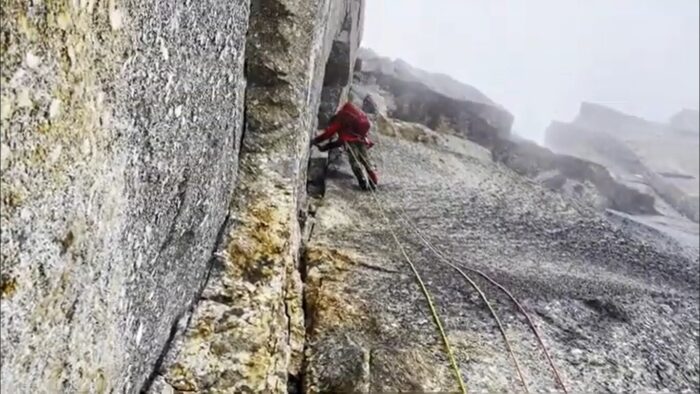In a surprise, the best climb done by Russians in 2024 went to three women: Olga Lukashenko, Darya Serupova, and Anastasia Kozlova. The all-women team won their country’s version of the Golden Ice Axe for a new big wall route on Argo Peak (4,750m) in Kyrgyzstan’s Pamirs.
The women are not new to mountaineering awards. Last year, Lukashenko won the Steel Angel, an independent prize for female teams, for a new route in the Tien Shan. Serupova and Kozlova were finalists. However, this year, the three women bagged the overall (not female) prize as a team.

The three women on Argo’s north face. Photo: Expedition team
Russia’s best
The Argo expedition prevailed through the various selection stages. “First, we chose a long list of highlighted expeditions. Then the jury selected six or seven ascents for the shortlist,” the Russian Federation of Mountaineering (RFM) told ExplorersWeb.
“The final choice was made between the two most significant ascents: Olga Lukashenko, Darya Serupova, and Anastasia Kozlova’s new route on Argo, and another first ascent of Peak 4810 by Ivan Temerev and Anton Kashevnik.”

Route on Argo, Kyrgyzstan. Photo: Russian Alpine Federation
“In the end, the Golden Ice Axe was awarded to the women’s team because their style was more in line with the spirit of the award,” Irina Morozova of the RFM said. “The Peak 4810 team bolted the route, with about 100 bolts installed in the wall with a drill hammer.”
Meanwhile, the women free-climbed the route on Argo. They graded it ED, 29 pitches, 1,250m long, 950m elevation gain, 7b, M5, А3.
In addition, the team previously climbed another new route on the southwest face of nearby Parus Peak (4,850m) for acclimatization. That line was graded as ED-, 28 pitches, 1,460m long, 1,150m elevation gain, 6c, M3, A2.
Hardship matters, not gender
Argo is a point of the Ashat Wall in the Gissaro-Alai range, a remote area where no female teams had ventured before. After the climb, leader Olga Lukashenko told Explorersweb:
Frankly, I don’t really care about the difference between male and female climbers, I’m just highlighting that this climbing area is genuinely serious and challenging. This discovery [that no women had previously attempted it] only added to the thrill of tackling such an uncharted and demanding climb.
The climbers faced not only highly difficult pitches but also rough conditions, with thick fog and wet rock part of the time.
For the 2024 expedition, the team received a Grit & Rock Expedition grant, promoting women climbers attempting new routes and exploratory expeditions.

The climbers faced some harsh weather on the face. Photo: Expedition team
Steel Angel
The Steel Angel, the award specifically reserved for international female teams, went to Slovenians Anja Petek and Patricija Verdev for their first ascent of 6,243m Lalung I in India’s Ladakh. Petek and Verdev were part of an all-female team that also included Ana Baumgartner and Ursa Kesar.
The women split into two teams. Petek and Verdev climbed Lalung I, while the other pair climbed two new routes on lesser peaks.


Patricija Verdev, left, and Anja Petek receive their Steel Angel award. Photo: Steel Angel Awards






